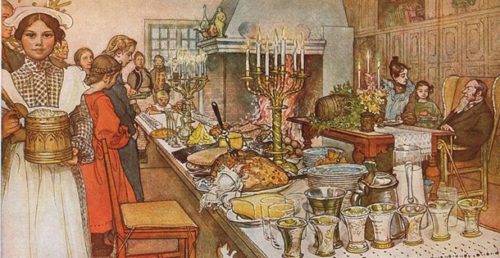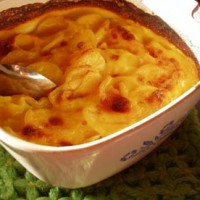Curtis Stone’s Simple Roast Chicken and Potatoes
This mouthwatering bird is a classic, and every family has their favorite version. Well here’s mine, which is made with just a few ingredients but has served my family and me very well over the years. Follow this recipe for a golden bird with juicy meat and some of the tastiest potatoes you could hope for. Stick with small Yukons — they are the perfect size, and their waxy skins become nice and crunchy.
Simple Roast Chicken and Potatoes
(Makes 6 servings)
- One 4-pound whole chicken, legs tied together
- 1 ½ tablespoons grapeseed oil
- 12 small Yukon gold potatoes (about 6 ounces each), halved
- 1 tablespoon all-purpose flour
- ¾ cup reduced-sodium chicken broth
Instructions
Position rack in center of oven and preheat oven to 425°F.
Place chicken on large heavy rimmed baking sheet. Rub ½ tablespoon of oil all over chicken and season with salt and pepper. In medium bowl, toss potatoes with remaining 1 tablespoon oil to coat. Season potatoes with salt and pepper and place them around chicken.
Roast for 55 minutes, or until thickest part of chicken thighs reach 160°F and the juices run clear when pierced and potatoes are tender but crisp on outside. Transfer chicken and potatoes to platter and let rest for 10 minutes before serving.
Meanwhile, pour pan drippings into small liquid measuring cup. Spoon off fat from drippings, reserving 1 tablespoon of fat. In small heavy saucepan, heat reserved fat over medium-high heat. Whisk in flour. Continue whisking for about 1 minute to cook flour. Whisk in pan drippings, broth, and any juices that have accumulated on platter. Simmer, whisking, for about 2 minutes, or until gravy thickens slightly. Season to taste with salt and pepper. Serve chicken and potatoes immediately with gravy.
Leftover chicken can be stored airtight in the refrigerator for up to two days and used for sandwiches, salads, or soups.
Per serving
- Calories: 586
- Total Fat: 26 g
- Saturated Fat: 7 g
- Sodium: 273 mg
- Carbohydrate: 56 g
- Fiber: 6 g
- Protein: 35 g
- Diabetic Exchanges: 4 starch, 4 lean meat, 4 fat
This article is featured in the September/October 2020 issue of The Saturday Evening Post. Subscribe to the magazine for more art, inspiring stories, fiction, humor, and features from our archives.
Credit: Photo by Ray Kachatorian. Excerpted from Good Food, Good Life by Curtis Stone. Copyright © 2015 by Curtis Stone. Excerpted by permission of Ballantine Books, a division of Random House LLC. All rights reserved.
Harriet Beecher Stowe Gets a Lesson in Boiled Potatoes
Sure, Harriet Beecher Stowe was an abolitionist and a women’s rights advocate. But did the prolific author who wrote one of the best-selling books of the 19th century know how to boil a potato? According to 1865 Post columnist Madeline, it was a hot debate.
—
Boiling Potatoes
Originally published in The Saturday Evening Post, December 2, 1865
The lady authoress of Uncle Tom, and diverse other popular publications, has been writing a homily on cooking potatoes. I should like to know if Mrs. Stowe does really boil potatoes herself? I do; and I have long since known better than to pare my potatoes raw and then dowse them naked into water red hot — boiling at 290 horse-power. That is one way to boil potatoes certainly, but not the proper one by a very long way. Philosophy, common sense, and a month or two of practical experience over the dinner pot, teach us a great deal better than that.
My dear madam, don’t you know that about six-tenths of all the starch that a potato affords, is deposited so near the surface, that however carefully we may pare the tubers in a raw state, we are sure to throw away the greater portion of that very material that we eat potatoes for? Then, if we toss our potatoes into boiling water, unprotected by their overcoats, we have set in a second, and hopelessly incorporated with the mass, that semi-volatile principle which gives the ill-cooked potato its slightly acrid something insipid, and always objectionable flavor.
Any thoroughly potato-bred Irish woman would as soon think of committing regicide, as boiling her potatoes undressed in the manner recommended by our literary lady cook. And there are no better potatoes, or potato cooks, anywhere in this world than there are in Ireland.
I tell you, fellow-housekeepers everywhere, that the correct way to cook a potato in any country, provided boiling is the determination, is to wash it clean firstly let it lie in clean, cold water 2 hours — 10 is all the better — place it in cold water in the pot, without paring, boil moderately until the test-fork goes smoothly through the potato without encountering a mite of core. Then drain off the water, set the pot over the fire, uncovered, for five minutes, after which whip off Mr. Potato’s jacket in a hurry, and send him to the table in a close cover, pip- ing hot-or if you are not over-fashionable and fastidious, it is preferable to serve “murphy” in his coat.
Please follow this formula a few times, and if you shall find it a pernicious practice, you shall be at liberty to consider Madeline as competent to write a readable romance, as she is to cook a potato.

Menus for a Christmas Dinner, 1913 Style

Looking for last-minute Christmas dinner ideas? Here are two full-course holiday meals — and a few choice recipes — circa 1913.
—
A Christmas Dinner
Originally published in The Country Gentleman, December 20, 1913
Menu No. 1
- Tomato Soup
- Croutons
- Celery
- Onions
- Pickles
- Roast Turkey with Oyster Dressing
- Hot Slaw
- Cranberry Soup
- Mashed Potatoes
- Baked Squash
- Stewed Onions
- Fruit and Nut Salad
- Cheese Straws
- Frozen Custard
- Plum pudding
- Raisins
- Coffee
- Mints
Menu No. 2
- Clear Soup
- Crackers
- Piccalilli
- Celery
- Currant Jelly
- Roast Duck with Walnut Stuffing
- Apple Sauce
- Candied Sweet Potatoes
- Scalloped Tomatoes
- Spinach
- Lettuce Salad
- Cheese Balls
- Suet Pudding
- Pumpkin Pie
- Coffee
- Fruit
- Nuts
These Recipes Are from Grandmother’s Cookbook
PLUM PUDDING — 1 cupful of molasses, 1 cupful of milk, 1 cupful of suet chopped fine, 2 eggs, 2 cupfuls of flour — or enough to make a batter as stiff as cake — 1 cupful of raisins, 1 cupful of currants, cupful of citron sliced, a tablespoonful of candied orange peel, a tablespoonful of candied lemon peel, 2 teaspoonfuls of cinnamon, 1/2 teaspoonful of cloves, 1/2 teaspoonful of nutmeg, 3 teaspoonfuls of mace, and a rounding teaspoonful of soda.
Before starting to mix this it is well to have the fruits prepared and floured, ready to mix in. When making follow the rotation of ingredients as given. Save a little of the milk to mix with the soda, which is added last. Steam three hours in an old-fashioned pudding mold with hole in center.
WALNUT STUFFING — Boil and mash a pound of white potatoes. Season them well with salt, pepper and butter, then add pint of chopped walnuts and the dressing is ready for use.
CANDIED SWEET POTATOES — Boil medium-sized sweet potatoes until done. When cold pare and cut in half lengthwise. Place the potatoes in a skillet in which a generous piece of butter and a little lard have been melted. Sprinkle the potatoes thickly with brown sugar, and fry on all sides an even brown. Watch closely, as they burn readily.
PUMPKIN CUSTARD — Three cupfuls of pumpkin, a cupful of milk, a cupful of sugar, a tablespoonful of butter, a teaspoonful each of ginger, cinnamon and finely sifted bread crumbs, and 3 eggs. Salt and nutmeg to taste.
Boil and drain the pumpkin well. Press through the colander and to 3 cupfuls of pumpkin add the melted butter, sugar, spices and crumbs. Mix thoroughly, add the well-beaten yolks of the eggs and the milk, and lastly the whites, beaten stiff.
BAKED SQUASH — Cut in half a large oval squash, remove the seeds and, after par-boiling, scrape out the pulp and put it through the ricer. Then into a buttered baking dish place the squash in layers, dredge each layer lightly with flour, add generous pieces of butter, season with paprika and salt, and moisten with cream. Cover the top layer with bread crumbs and dot liberally with butter. This recipe should take about a cupful of milk and 2 tablespoonfuls of flour. Bake until brown.
OYSTER STUFFING — Melt a cupful of butter on the top of the stove and add 50 good-sized oysters drained from the liquor. Cook slightly until the gills begin to curl. Then add the oyster liquor and enough crumbed bread to fill the turkey. If this mixture is dry add sufficient milk to make it pretty moist. Season with salt and pepper and about 2 tablespoonfuls of minced parsley. Last of all add 4 or 5 well-beaten eggs. Cook this mixture until it is well thickened before putting it into the turkey.
FROZEN CUSTARD — Make a boiled custard with 3 cupfuls of milk, the yolks of 4 eggs and the whites of 2. Sweeten to taste. Let the custard cool and then add a teaspoonful of vanilla and a cupful of good cream. Freeze. Just before packing it away fold in the whites of 2 eggs which have been beaten light with 2 tablespoonfuls of sugar.
HOT SLAW — Chop fine a small head of cabbage. Beat together a cupful of sour cream, an egg, a tablespoonful of sugar and half a teaspoonful of mustard dissolved in cupful of vinegar. Have a pan hot, pour in the mixture and when the boiling point is reached add the cabbage well-floured and salted. Heat through and serve with a dash of paprika on the top.

Easy Homemade Scalloped Potatoes
Did You Know?
Yellow potatoes contain 810 mg of potassium. Their potassium content is higher than broccoli, bananas, and tomatoes. As such, these potatoes can help reduce the risk of hypertension and stroke and help maintain lean body mass.
Easy Homemade Scalloped Potatoes
(Makes 4 to 5 servings)

- Cooking spray
- 1 tablespoon olive oil
- 1 small yellow onion
- 2 cloves garlic, chopped
- 2 cups mushrooms, sliced
- 4 to 5 medium yellow potatoes, thinly sliced (peeling optional)
- 1/2 cup Parmesan cheese
- Pepper
- 1 cup milk or soy milk
Preheat oven to 350 F. Coat 8-inch casserole dish with cooking spray.
In medium saucepan, heat oil and saute onion for 1 to 2 minutes. Add garlic and mushrooms and saute additional 1 to 2 minutes. Remove from heat and set aside. Line bottom of casserole dish with layer of 1/3 of the potato slices, gently overlapping like shingles. Sprinkle with pepper and 1/3 of the cheese. Add half of the sauteed veggies. Repeat potato layer, sprinkle with pepper, half of the remaining cheese, and other half of the veggies. Top with final layer of potatoes. Sprinkle with pepper and cheese. Pour the milk over the layers and bake for about 1 hour and 15 minutes. [Halfway through baking, gently press top layer of potatoes down.